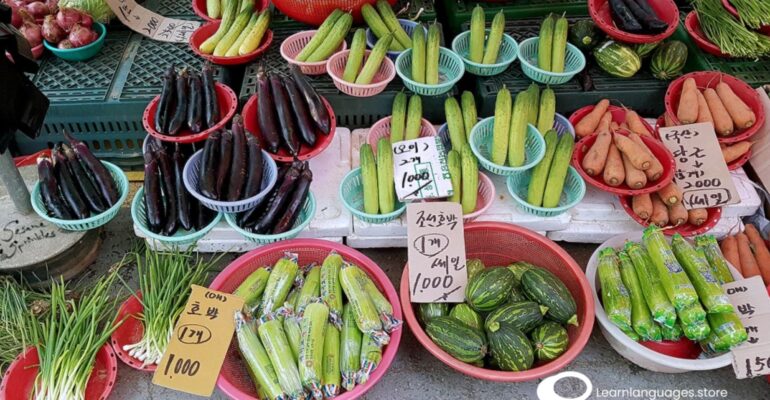20+ Most Common (and Unique!) Vegetables in Korean
20+ Most Common (and Unique!) Vegetables in Korean
Korean food is well-known for its vivacious tastes and variety of ingredients. In Korean cuisine, vegetables are essential because they provide meals flavor, color, and nutritional content. We will look at more than 30 of the most popular and distinctive veggies used in Korean cooking in this post. This list, which includes both well-known favorites and lesser-known hidden treasures, can help you learn more about Korean cuisine and get ideas for your next culinary journey.
Estimated reading time: 4 minutes

무 (Mu) – Radish: Radishes are a staple in Korean cuisine, used in various forms, including pickled radish (단무지, Danmuji) and radish kimchi (깍두기, Kkakdugi).
배추 (Baechu) – Napa Cabbage: Napa cabbage is the main ingredient in the iconic Korean kimchi (배추김치, Baechu Kimchi), a fermented vegetable dish.
상추 (Sangchu) – Lettuce: Lettuce is commonly used as a wrapping ingredient for Korean barbecue (삼겹살, Samgyeopsal) and other grilled dishes.
시금치 (Sigeumchi) – Spinach: Spinach is often blanched and seasoned with sesame oil and soy sauce to create a popular Korean side dish called 시금치나물 (Sigeumchi Namul).
호박 (Hobak) – Pumpkin: Pumpkin is used in a variety of Korean dishes, including hobakjuk (호박죽), a sweet pumpkin porridge enjoyed as a dessert or snack.
오이 (Oi) – Cucumber: Cucumbers are commonly enjoyed fresh or used in dishes such as oi-muchim (오이무침), a spicy cucumber salad.
고구마 (Goguma) – Sweet Potato: Sweet potatoes are a versatile ingredient in Korean cuisine, used in both savory and sweet dishes, such as goguma-mattang (고구마맛탕), candied sweet potatoes.
미나리 (Minari) – Water Dropwort: Water dropwort is a leafy green vegetable often used in stews and salads, adding a distinct flavor to the dish.
부추 (Buchu) – Chives: Chives are used as a garnish in many Korean dishes and are also a key ingredient in dishes like buchujeon (부추전), a savory chive pancake.
콩나물 (Kongnamul) – Soybean Sprouts: Soybean sprouts are a common ingredient in Korean cuisine, used in soups, stews, and side dishes like kongnamul-muchim (콩나물무침), seasoned soybean sprouts.
미나리 (Minari) – Korean Water Parsley: Korean water parsley is a herb used in various dishes, including soups and stir-fries, adding a refreshing taste.
단호박 (Dan Hobak) – Korean Sweet Pumpkin: Dan hobak is a small, sweet pumpkin variety used in traditional Korean desserts and porridges.
취나물 (Chwinamul) – Aster Scaber: Chwinamul is a wild leafy green vegetable commonly blanched and seasoned to create a nutritious side dish.
청경채 (Cheonggyeongchae) – Garland Chrysanthemum: Garland chrysanthemum leaves are often blanched and enjoyed as a side dish or added to stews for a unique flavor.
쑥갓 (Ssukgat) – Crown Daisy: Crown daisy leaves are used in a variety of Korean dishes, including namul (나물), seasoned vegetable side dishes.
열무 (Yeolmu) – Korean Radish Greens: Korean radish greens are enjoyed fresh or used in traditional dishes like yeolmu-mul-kimchi (열무물김치), a water radish greens kimchi.
도라지 (Doraji) – Bellflower Root: Bellflower root is commonly used in Korean traditional dishes like doraji-muchim (도라지무침), a seasoned bellflower root side dish.
삼채 (Samchae) – Aster Scaber Stems: Aster scaber stems are used in traditional dishes like samchae-muchim (삼채무침), a seasoned aster scaber stem side dish.
비트 (Biteu) – Beetroot: Beetroot is used in various Korean dishes, including salads and banchan (side dishes).
깻잎 (Kkaenip) – Perilla Leaves: Perilla leaves are commonly used as wraps for grilled meat and are also enjoyed pickled or used in soups.
꽈리고추 (Kkwari Gochu) – Korean Wild Chili Pepper: Korean wild chili peppers are known for their vibrant red color and are used to add heat to dishes like kimchi and stews.
Conclusion:
Your culinary adventures will be more interesting and varied if you explore the wide world of Korean veggies. Korean cuisine provides a wide variety of vegetable alternatives to explore, ranging from the traditional radish and cabbage to unusual greens like doraji and ssukgat. Cook with these veggies, try out some classic Korean dishes, and enjoy the tastes of this illustrious culinary culture.
Learn Languages Store
Vashi,
Email: services@learnlanguages.store










